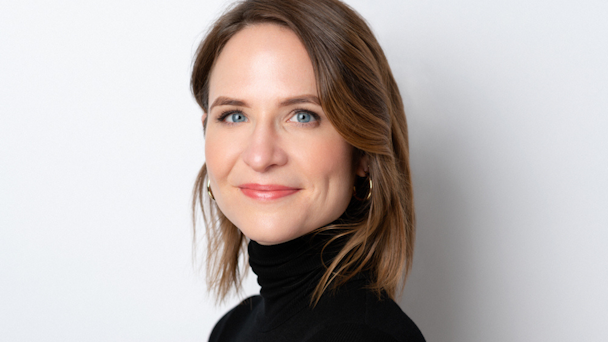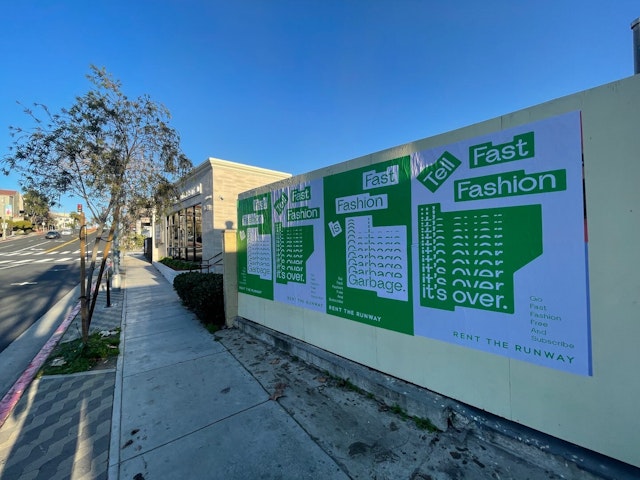Rent the Runway marketing exec on trashing fast fashion
Following the launch of its new bold brand campaign encouraging consumers to ditch fast fashion, Rent the Runway’s senior vice-president of brand marketing Jess Burns gets candid about pandemic-related trials and tribulations, 2022 trends in fashion and retail, and the brand’s vision for transforming the industry – one rental at a time.

Rent the Runway’s senior vice-president of brand marketing Jess Burns says the brand has major growth plans for 2022
The US Environmental Protection Agency estimates that each year, landfills take in 11.3m tons of textiles – making up some 7.7% of total municipal solid waste landfill space. At the same time, the rate of clothing and apparel production continues to skyrocket. On a mission to break this cycle of waste is direct-to-consumer (DTC) designer fashion rental company Rent the Runway.
Last week, the brand unveiled its new ‘Fast Fashion Free’ campaign, featuring bold messaging and visuals developed by creatives at YummyColours encouraging consumers to ditch unsustainable fashion in favor of rental designer wear. The campaign also entails a partnership between the company’s New York headquarters and Green Textiles through which consumers can recycle unwearable fast fashion that will then be recycled to create insulation. But the brand says this is just the beginning.
Here, the company’s senior vice-president of brand marketing Jess Burns talks brash marketing, 2022 trends and why she believes the future of fashion is rented, not bought.
Tell us about the inspiration behind the new Fast Fashion Free campaign.
This campaign is really about living our purpose. A lot of brands will kind of scramble to try to figure out where they should focus on purpose ... or they lean into some flash-in-the-pan social impact program because [they think] it will make them more authentic. But this is really at the core of what we do. This campaign isn’t just an ephemeral strategy – this messaging is a core fiber and focus of our business. And as we think about communicating the value prop of Rent the Runway, being a more sustainability-focused company is a key consideration for us, but also for customers as they look to re-evaluate the brands that they choose to invest in.
We decided to launch this campaign [this month] because it was a very timely strategy, given that everyone is re-evaluating their behaviors and bad habits [at the start of the new year]. As we think about consumers being more conscientious during this time, we felt like it was really timely to introduce Rent the Runway as a way for customers to dress in a way that’s ... healthier for the environment.

The campaign was intentionally provocative, and you’re going to see a lot more of that from Rent the Runway. We want to be very clear on what we stand for, and we want to be a bit louder on how we do that. With this campaign [we wanted to emphasize that] fast fashion is garbage. It’s ending up in landfills. It’s time for people to reconsider their habits when purchasing fast fashion. We were also very intentional about the media channels we chose to invest in. We worked with Seen Media and LinkNYC [to launch] out-of-home (OOH) activations – [including] both wild postings and digital billboards right outside of fast fashion retailers. We want to stop people at the last moment of truth before they go into a fast fashion retailer and [encourage them to instead consider] investing in a subscription to Rent the Runway.
What’s the brand’s sustainability vision, writ large? How are you thinking about changing behavior more broadly?
Sustainability is at the core of our mission, business model and our financial model. [We want to educate consumers that] increasing the number of times that the clothes in our closet and [from Rent the Runway’s] cloud are worn improves positive environmental impact and financial outcomes.
Earlier this year, we invested in a study called the Life Cycle Assessment study, and what we learned is that when a customer rents a garment from our closet in the cloud, the result is net environmental savings compared to purchasing clothing ... and those are net environmental savings across water usage, energy uses and CO2 emissions. You know, when you look at other retailers, they kind of have to tack on a sustainability or social impact program. Our business was built around this. Right now we are in a position to be able to communicate that very confidently – that we are one of the very few players in this industry that are telling people to buy less, but they can effectively wear more. That is what we think is a really exciting solution to fast fashion. Our chief exec Jen Hyman said: “We exist to put fast fashion out of business.” Before Rent the Runway, there weren’t many solutions to really combat that.
Through a lot of the studies that we’ve done, we've learned that 89% of our subscribers say that they buy less clothing altogether [since joining Rent the Runway]. 83% specifically say they buy less fast fashion when they have a subscription to Rent the Runway. When we scale the value of Rent the Runway to millions of women, [these statistics] will really appeal to them.
We are going to be releasing our sustainability goals in March ... so people really understand what we’re striving for. We are one of the very few players that are very vocal, and I think very fair and clear on what we actually mean when we say we are a more sustainable business. I think we’re really setting the tone for the industry overall.
The sustainability movement in fashion appears to be in the early stages still, but we are seeing brands and retailers increasingly leaning into and promoting sustainability – such as Levi’s ‘Buy Better, Wear Longer’ initiative. How does Rent the Runway plan to carve out a competitive advantage and grow its business?
The industry as a whole has a lot of work to do. One of the data points that always startles me is that if our industry stays the way it is with no changes, an estimated 115m tons of clothing will be in a landfill by 2050. [But] I’m encouraged that more retailers and more fashion and apparel brands are starting to re-examine how they can be more sustainable businesses.
We were one of the first players in the space to really understand that. The job to be done for us is really to continue to scale the relevancy of renting. There’s more work to be done there. As far as competing with other players coming into this space, you know, we’ve been doing this for 13 years, between building the operations around our rental business and building the relationships with 750-plus designers. We’ve been doing it for a while now ... I would hope that [other players in the space] would look to us for some of the ways that we’ve been able to make it relevant to customers ... and done it successfully.
Talk to me about the impact that the pandemic has had on your business. It’s been widely reported that fashion and retail players including Rent the Runway have struggled in the face of stay-at-home orders and decreased social activity. How have you approached these challenges and what is 2022 looking like from your vantage point?
A lot of consumer behaviors have shifted during Covid, but we actually saw them as beneficial to our business.
Obviously, customers are having more conscious conversations around sustainability and wanting to live sustainably ... so Rent the Runway provides a valuable solution to them. A lot of other trends we’ve seen are around access versus ownership. You look at other business models such as Airbnb or Spotify – these business models are continuing to be more important for customers. We are very much aligned with that.
Another key trend that we have been seeing during the pandemic is a focus on more financial savings, and a business model like ours [enables consumers to] get, over the course of a year, thousands and thousands of dollars in value from a subscription that is a pretty low investment per month. So, it’s just a smarter choice. [The overarching] trend is seeing customers make smarter decisions because of the uncertainty and volatility out there right now. [Another] thing that is really encouraging for our business is the continued growth in e-commerce, and people continuing to spend their dollars online. All [of these] trends are really powerful tailwinds in favor of people supporting Rent the Runway’s Closet in the Cloud.
We can expect to become more relevant throughout the year as the world continues to open back up. [A misconception we want to dismantle is that] Rent the Runway’s Closet in the Cloud isn’t about dressing for special occasions – it’s really about dressing for every day, [whether it’s] wearing a really beautiful top on your work Zoom call or ... deciding to invest in more loungewear through our subscription platform.
When it comes to scaling the relevancy of Rent the Runway and making it more tangible to millions of women, the focus is on our subscription business. We want to hijack this buying mindset ... and change customer behavior into more of a renting mindset. [Right now], it’s getting colder and when women are thinking, ‘Oh, this is a new season, I need to get a bunch of new coats.’ It’s really about stepping into that thought process and getting [every woman] to think about a subscription to fashion as a solution for when she needs clothing for new seasons and for moments large and small. We’re excited about solving for this challenge in the next couple of years as we continue to invest in brand marketing. We’re a disruptive brand, and we’re going to continue to invest in disruptive marketing to make sure customers are aware of renting as a solution.
Moving beyond the company’s core focus on sustainability, how is Rent the Runway focused on innovation at this moment in time?
We’re evolving the end-to-end experience for our customers ... to make it easier and even more fun to pick garments on Rent the Runway but also ... from a [supply chain and logistics] perspective.
We’re evolving ways to be able to drop off your garments. We’re evolving ways for them to be picked up at your house. We’ve already launched at-home pickup where you can not only pick from all 750 designers and get multiple garments sent to you on a monthly basis, but also have them picked up as well. We’re thinking about the end-to-end experience and making sure it’s streamlined and delightful and a more fun shopping experience than traditional DTC e-commerce.
From the brand marketing perspective, what is your vision for 2022 and beyond?
You’re going to see more of us out there. It’s really exciting to think about ways to clearly communicate our value proposition over the next year, not just when it comes to sustainability – although that’s a core focus – but really in demonstrating to customers the value, and how much more fun Rent the Runway is for everyday dressing. We’re investing in full-funnel [initiatives].
You’re going to continue to see more brand marketing campaigns over the course of the next year. We’re going to think about how to evolve our brand strategy to make this subscription to the Closet in the Cloud more relevant to millions of women out there. We’re going to invest and test channels that we can use to most effectively reach our target customer where she’s at. This sustainability campaign is really setting the tone for how we want to communicate to customers going forward.

